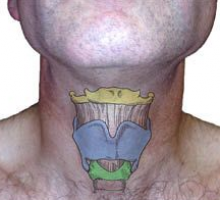Anatomy of the Voice Box
Sipping espresso in Ken’s Boulangerie & Cafe, I hear the background noise of the espresso grinder mingling with the murmur of voices. The couple next to me are chatting in Japanese, drinking coffee and downing a pastry. I don’t understand a word, but I can hear that each person’s voice box, or more technically the larynx, is functioning well.
The larynx is designed to control the flow of food, air and sound. Each person takes a sip of coffee, swallows, breathes in and then engages in repartee. Liquids and solids are separated from the air each individual breathes, then directed down the esophagus. Air is directed between the vocal cords into his and her lungs. The air is put to use again to make sound on its way back out. The larynx does all of this work, all very rapidly.
Thus, the larynx is basically a valve, a talented valve, with three functions:
1. Regulate breathing,
2. Create sound and
3. Keep food and liquids out of the lungs.
Of course, we have all seen someone blast his friend with drink when he rushes his larynx and tries to swallow and talk simultaneously. It helps to have a microsecond or two between functions. 
As the young man beside me swallows his coffee, I see a bulge moving up and down on the front of his neck. We call this protuberance in a man’s neck, the “Adam’s apple” or medically speaking, the thyroid cartilage. The thyroid cartilage starts out soft and enlarges when exposed to testosterone, perhaps partly for evolutionary mating reasons. The net external effect is that it protrudes visibly. On the inside testosterone thickens and elongates the vocal cords. The longer and thicker they end up, the lower the notes they are capable of producing. The thyroid cartilage sits on top of the cricoid cartilage. Below the larynx is the windpipe or trachea, which you can feel in some people with thin necks. Above the Adam’s Apple is the hyoid bone, which helps suspend the larynx in the neck.
The hyoid bone (top yellow) is connected to the tongue and jaw muscles above and the thyroid cartilage below. The thyroid cartilage (central blue) is also known as the Adams Apple and protects the vocal cords which are attached on the backside in the middle. The cricoid cartilage (lower green) is a complete ring supporting the bottom of the larynx.
Want to know more about the inner workings of the throat? Read more within the pages of my book, "Why is There a Frog in My Throat?"
